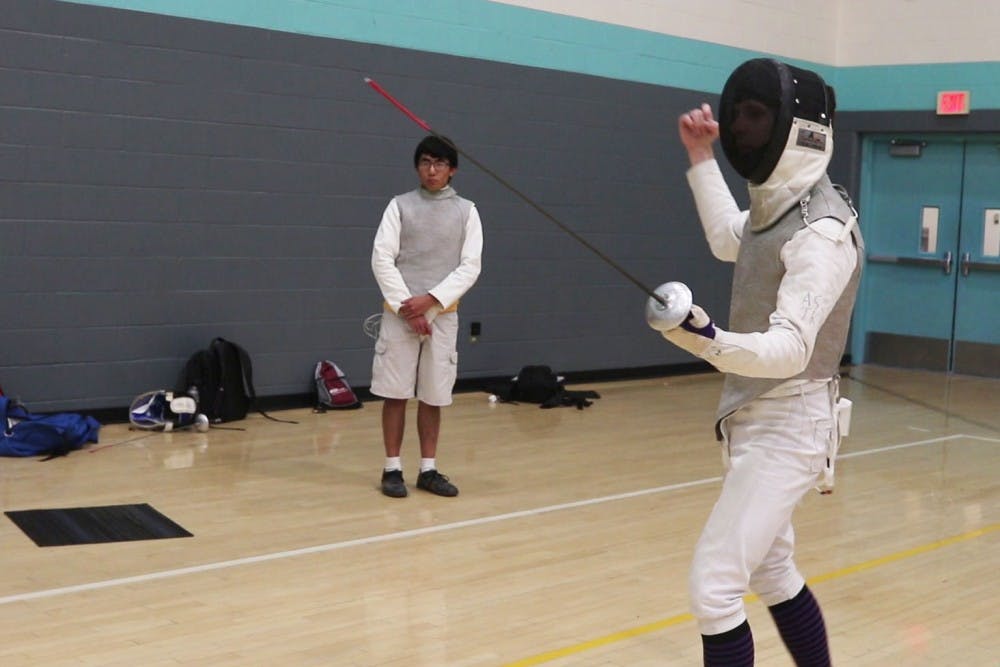ASU Fencing Club President and Vice President Ethan Greshenfeld and Ethan Birnbaum discuss how the current status of the club, originally founded in 1977, is different from past iterations. Women's Captain Lauren Baldwin describes all of the different types of fencing the club practices. Birnbaum and Greshenfeld say what their hopes are for the future of the club and why fencing is a unique sport.
[0:00] Ethan Greshenfeld: So fencing is unique in that it’s just as much mental as it is physical. So, you do have to be in shape and you’re just moving down a fourteen-meter strip but it’s a lot more exercise than what people think. But also, it’s kinda like the chess of sports is what a lot of fencers say so you have to use a lot of mind games and mind tricks and try to out think the opponent at every turn.
[0:21] Austin Villegas: The ASU Fencing League has been around since 1977, having gone through multiple iterations, President Ethen Greshenfeld and Vice President Ethan Birnbaum commented on the leagues current status compared to the previous years
[0:34] Ethan Greshenfeld: So, the first iteration of ASU fencing was about forty or so years ago and started back in the early seventies. It’s had ups and downs throughout its years, we’ve had years where we have NCAA status and we have backers and funding and for a brief period wheel chair fencing. And now we’re kinda in our inter-colligate circuit and so we compete within the southern California division and with U of A (University of Arizona) for our titles every year.
[1:02] Ethan Birnbaum: When the club had a little more funding it diffidently was more organized. In my first semester, my first year here it was diffidently a little more disorganized, the club didn’t have much structure. Which is why this semester, with Greshenfeld and I in charge, we’ve diffidently really really tried to implement a lot more structure into our practices making things a lot more routine. We come in, we get together, we have announcements, then we stretch then we go right into foot work drills and conditioning. Based on how people are preforming and what people are starting with, Greshenfeld and I will make an actual schedule of what kind of footwork drills we want to do to help people along. So diffidently this semester there’s a lot more structure in the club.
[1:40] Austin Villegas: ASU’s fencing league is the only one of its type in Arizona to practice all 3 different types of regulation fencing Lauren Baldwin, Women’s Captain, shared what these three are and how they’re different.
[1:49] Lauren Baldwin: So, we have three different weapons that we fence, we’re a full weapon club so those three weapons are all the possible to fence in. We have FA, which is the standard, it is a full contact, everywhere is target area and it’s not, you only wear one jacket basically. There’s also foil, which is specific target area it is the chest and the helmet, and it has different swords they’re a little lighter a little smaller. And our last one is saber, which is full eclectic, you wear a full eclectic jacket, mask and glove are the target areas and their blades are a little longer, flickier and have a different bowguard.
[2:30] Austin Villegas: Birnbaum and Greshenfeld said what their hopes are for the future of the club and their favorite aspects of fencing as a sport.
[2:38] Ethan Birnbaum: Competitively at the moment, this last year in our collegiate events we placed second overall but I do want to get everyone in the club into U S of A events which is the more national, all the national events all for the U S of A meetings, that’s what I really want to get our team into and really start showing them what competitive fencing is. And then getting them into meeting new people, that’s something that diffidently helps new fencers grow is fencing new people.
[3:03] Ethan Greshenfeld: The great thing about fencing as a sport is that you can interact with the best of the best on a regular basis. So, like I can go to nationals and I can fence with Olympians, or they’ll just walk around and sign my jacket just because they’re there. It’s a really accessible and friendly community and I love that about this sport.
Reach the reporter at amville8@asu.edu or follow @AustinMVillegas on Twitter.
Like State Press on Facebook and follow @statepress on Twitter.




